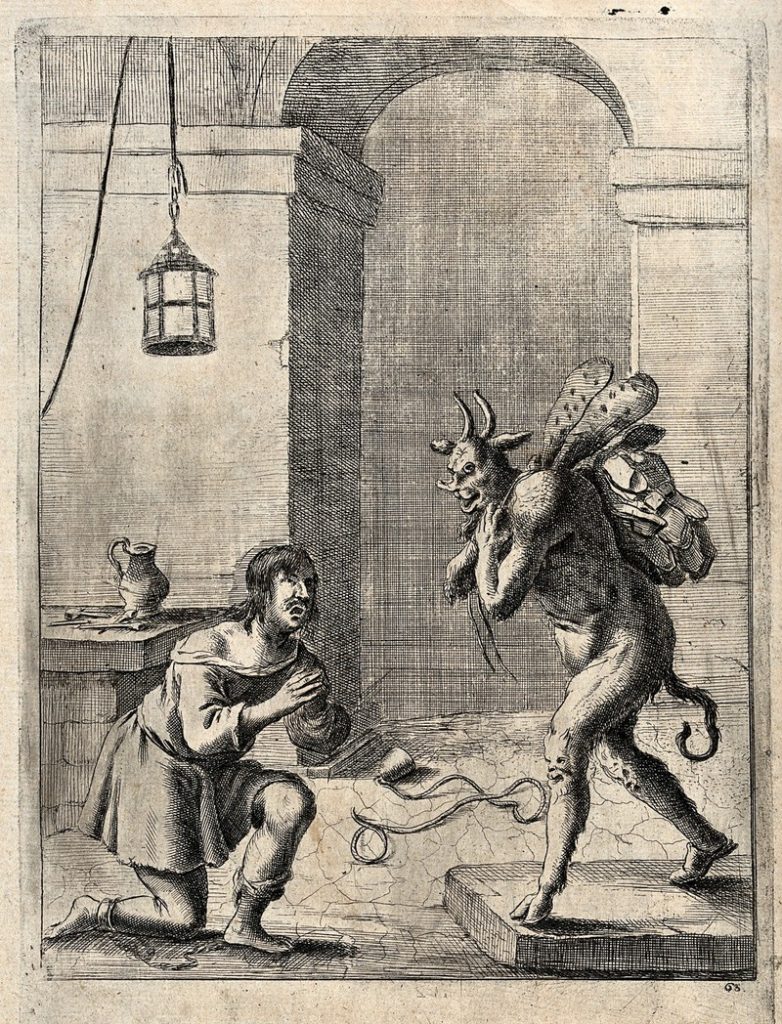Devil Wings Mystery November 21, 2017
Author: Beach Combing | in : Modern , trackbackThis site has pioneered the study of fairy wings. In the last years a number of posts have pointed to the origins of fairy wings in Britain in the late eighteenth century; looked at fairy wings types; and even looked at how fairy wings were constructed by anxious mothers in the 1800s. Our colleague and fellow-blogger Chris Woodyard has just though thrown one of her interesting stink bombs in our general direction. This image above appears in The Devil in Britain and America by John Ashton, 1896. Ashton gathered together a number of contemporary (i.e. 17C and 18C) images together and used them in his work. Irritatingly though he did not identify where this marvelous image came from. (Or as it happens any others he employed: bad Victorian historian!)
What the image shows is a typical sabbat. Women and devils are sitting around a table enjoying roast baby. Notice how the women come from different social classes: i.e. the devil is everywhere. All our witch sources would suggest that this meal was followed or preceded by some very unpleasant sexual intercourse. In any case, what caught Chris’ attention were the devils’ wings: huge thanks to Chris for this nod. Now devils, as fallen angels, have wings, but the normal convention, dating back to Late Antiquity, is to give them bats wings. Yet here they seem to have borrowed, as fairies would a century or so later, from the insect kingdom. What the heck is going on? It is always possible that our artist had ingested some fly agaric: it happens to the best of illustrators at some point or other.
But Chris was not happy with this solution and proceeded to dig out more of these damn moth- or may-fly demons. Here is one from the late 1600s, first half 1700s (undated)? And here is one dated to 1720: though not 100% convinced these are moth/insect wings.

This is certainly a minority tradition within the greater tradition of lizard noses and bats’ wings. But where does it come from? What does it mean? And does it infect the fairy tradition? drbeachcombing AT gmail DOT com
30 Nov 2017: Chris S writes ‘When fairies got their wings, those appendages resembled those of insects. Devils with insect wings may come from religious zealots who saw the fairy-faith as heresy with fairies as little devils. Faithful humans, as I presume thinking could’ve gone, can see beyond the glamour and apprehend fairies in their full infernal glory. A little more simple, devils have wings because angels have wings. Devils are naught but fallen angels, much like their boss. Rather than beautiful white wings with proper, snow-white feathers, theirs are from filthy, shit-eating flies and other insects known to nourish themselves with the dead. All the more reason to pound one’s bible and pursue a life of celibate piety, rather than leaving out a nightly saucer of milk and honey for the Good Folk.’
30 Dec 2017: Dear Dr. Beachcombing: Perhaps the devil (winged or otherwise) makes us look at pictures on your site and cry, ‘Fake!’ At any rate, we’re doing it again. In all probability the topmost image (from John Ashton’s book) is late 19th century. In the earliest days of printing, images were usually produced as woodcuts. By the seventeenth century, engraving and etching were the most common method of image reproduction in books. Photo reproduction only became common in the late 19th century. With this development, printers could cheaply and efficiently reproduce pen and ink drawings. The cross hatching in the shadows excludes woodblock, and the lines are too rough to be engraving or etching, so the medium sure looks like pen and ink. Look carefully at the faces of the figures behind the table. When the lines of the hatching meet, the ink appears blotted. Blots occur when the illustrator runs a second line into the first when the ink on the first is still wet. This only happens with pen and ink and is not a mark of high skill. Assuming the medium is pen and ink, either the drawing came from a centuries old manuscript or it was created for reproduction in the late 19th century. We argue the latter. If Mr. Ashton provided poor quality image, the printer would have had the image redrawn. A cursory examination of ‘The Devil in Britain and America’ shows a number images which appear to be pen and ink. They come from different times and places, but the draftsmanship is consistent throughout. This indicates redrawing. This task often went to an apprentice, which would be consistent with the poor quality of draftsmanship. Many years ago, we were apprenticed in a graphic arts shop and spent a certain amount of time doing similar tasks– usually without supervision. (Today, we cringe when we think of the quality of our work.) A 19th century printers apprentice with an imagination would have had a lot of fun. In our youth, we would certainly not have been above improving the original, adding a wing here and there or even an embryonic piece de resistance. Bon appetite! Leif
29 Jan 2018: Invisible writes ‘Interesting that Leif thought, as I did, that the devil wings image was redrawn from an original. I’m not sure that I subscribe to the idea that it has been “improved” because of the other, genuine images with similar wings, but it is a theory. I wonder if the redrawing, which Leif says is throughout the book, was to avoid paying image permission fees?’
Beach adds: agree with doubts about improvement. Less sure about any need to pay for images. 19C books pretty reckless about that anyway?




